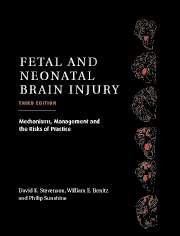Book contents
- Frontmatter
- Contents
- List of contributors
- Foreword
- Preface
- Part I Epidemiology, Pathophysiology, and Pathogenesis of Fetal and Neonatal Brain Injury
- Part II Pregnancy, Labor, and Delivery Complications Causing Brain Injury
- 9 Maternal diseases that affect fetal development
- 10 Antepartum evaluation of fetal well-being
- 11 Intrapartum evaluation of the fetus
- 12 Obstetrical conditions and practices that affect the fetus and newborn
- 13 Fetal and neonatal injury as a consequence of maternal substance abuse
- 14 Chorioamnionitis and its possible relation to subsequent cerebral palsy
- 15 Bacterial sepsis in the neonate
- 16 Neonatal bacterial meningitis
- 17 Neurological sequelae of congenital perinatal infection
- 18 Perinatal human immunodeficiency virus infection
- 19 Inborn errors of metabolism with features of hypoxic–ischemic encephalopathy
- Part III Diagnosis of the Infant with Asphyxia
- Part IV Specific Conditions Associated with Fetal and Neonatal Brain Injury
- Part V Management of the Depressed or Neurologically Dysfunctional Neonate
- Part VI Assessing the Outcome of the Asphyxiated Infant
- Index
- Plate section
19 - Inborn errors of metabolism with features of hypoxic–ischemic encephalopathy
from Part II - Pregnancy, Labor, and Delivery Complications Causing Brain Injury
Published online by Cambridge University Press: 10 November 2010
- Frontmatter
- Contents
- List of contributors
- Foreword
- Preface
- Part I Epidemiology, Pathophysiology, and Pathogenesis of Fetal and Neonatal Brain Injury
- Part II Pregnancy, Labor, and Delivery Complications Causing Brain Injury
- 9 Maternal diseases that affect fetal development
- 10 Antepartum evaluation of fetal well-being
- 11 Intrapartum evaluation of the fetus
- 12 Obstetrical conditions and practices that affect the fetus and newborn
- 13 Fetal and neonatal injury as a consequence of maternal substance abuse
- 14 Chorioamnionitis and its possible relation to subsequent cerebral palsy
- 15 Bacterial sepsis in the neonate
- 16 Neonatal bacterial meningitis
- 17 Neurological sequelae of congenital perinatal infection
- 18 Perinatal human immunodeficiency virus infection
- 19 Inborn errors of metabolism with features of hypoxic–ischemic encephalopathy
- Part III Diagnosis of the Infant with Asphyxia
- Part IV Specific Conditions Associated with Fetal and Neonatal Brain Injury
- Part V Management of the Depressed or Neurologically Dysfunctional Neonate
- Part VI Assessing the Outcome of the Asphyxiated Infant
- Index
- Plate section
Summary
Introduction
Inborn errors of metabolism that present in the neonatal period can have clinical, biochemical, and neuroradiologic features similar to those of hypoxic–ischemic encephalopathy (HIE). Both metabolic disorders and HIE are associated with severe neurologic distress, metabolic acidosis, and multiorgan system involvement. In general, the patterns of brain injury are different when HIE and inborn errors of metabolism are compared. However, some metabolic disorders may have neuroradiologic findings similar to those seen in HIE. Although inborn errors are rare individually, as a group they affect approximately 1 in 1000 neonates. It is crucial to consider these disorders in the differential diagnosis of patients who present with nonspecific features suggestive of sepsis or asphyxia. Prompt diagnosis may not only prevent mortality or significant morbidity, but also allows the clinician to provide the family with accurate genetic counseling. In this chapter, patterns of brain injury and systemic complications that occur in HIE and metabolic disorders are reviewed. Specific inborn errors of metabolism with clinical presentations that may be seen in patients with HIE are discussed further. For a more comprehensive review of inborn errors of metabolism, the reader is referred to standard metabolic texts.
Patterns of brain injury in HIE and inborn errors of metabolism
Neonatal hypoxic–ischemic brain injury may be caused by localized infarction or a diffuse ischemic insult. Focal ischemic infarction in the neonate typically presents with lethargy, hypotonia, or seizures. Metabolic causes of focal ischemia are listed in Table 19.1, but will not be reviewed in this chapter.
- Type
- Chapter
- Information
- Fetal and Neonatal Brain InjuryMechanisms, Management and the Risks of Practice, pp. 392 - 408Publisher: Cambridge University PressPrint publication year: 2003



